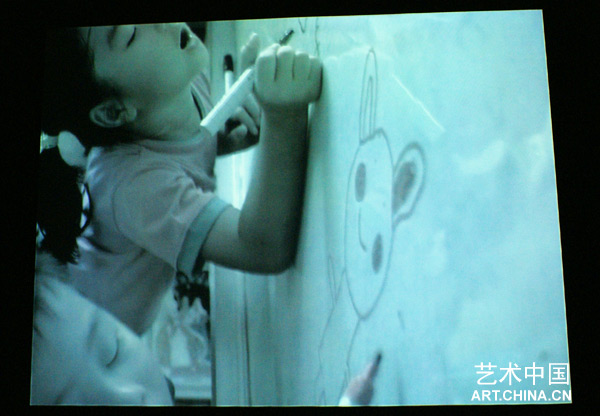|

台灣藝術家曾禦欽生於1978年,畢業于台北藝術大學。視自己為實驗電影製作者的曾禦欽是台灣最新一代電影人的代表,他的許多電影作品能在網路上看到。在曾禦欽的影像作品中,他描述了他那些角色的孤獨。藝術家慣用的表現形式有時像是一種飽含折磨的、哀歌式的小型戲劇,在語言限制的邊緣滑行。
有人認為曾禦欽的藝術創作,不論是觸及到記憶的發生或片段,整個創作的基調掌握表現出一種低調苦澀,以及欲語還休的心境。2007年曾禦欽在卡塞爾文獻展上展示的作品《有誰聽見了》,描繪了幾個孩子,他們頭上被澆上了優酪乳,對著鏡頭露出笑容。他的作品使人想到了70、80年代台灣實驗電影中洋溢著的濃郁的人文色彩。
這次,曾禦欽帶來的作品有雙頻錄影作品《我痛恨假設》。兩個相對的螢幕上播放著相似的畫面——一輛大巴上坐滿了像是剛剛放學的孩子,他們都閉著眼睛,隨著清脆的背景音樂的節奏和汽車行駛的晃動輕輕地搖擺著身體。之所以會製作一件這樣的作品,其感觸來源於藝術家某個夜晚的突然驚醒。身旁睡的人到底是誰,猛然間好像完全沒有了記憶,也一點都不熟悉。他想到,年少的時候坐在公車上,艷陽隔著玻璃窗投射在身上,車內冷氣涼涼、懶懶的,不自覺地就閉上了眼,那種舒舒服服的感覺是多麼讓人難忘。因此,藝術家希望生命的過程是不是可以如此——閉上眼;不看,關上耳;不聽,只留嘴去呼吸、肌膚去體驗週遭冷暖。曾禦欽的作品提出了一個值得深思的問題:在人與人之間,集體與個人之間,文明的傳承與遺忘之間,如何找到一個人的位置和身份?

Taiwanese artist Tseng Yu-Chin was born in 1978 and graduated from the Taipei National University of the Arts. Seeing himself as a producer of experimental cinema, he is a representative of the latest generation of Taiwanese filmmakers, and many of his films are available on the internet. In his video works, he depicts the loneliness and solitude of his actors. His mode of expression is often ripe with torment and the rhetoric of martyrdom, turning his work into mournful short dramas that drift along the boundaries of language.
It has been said that Tseng Yu-Chin’s work, encompassing the fragments and recollections of memory, brings forth as its main chord a mellow bitterness that remains in the heart but can never be spoken. The piece he showed at Documenta XII in 2007, who is listening, depicts several children having milk poured over their heads while smiling at the lens. Such works recall the deeply humanistic atmospheric touches of Taiwanese experimental film from the 1970s and 1980s.

For this exhibition, Tseng Yu-Chin presents the dual channel video piece Assumption of I Hate Assumption. Similar images are projected on two facing screens: the scene is a schoolbus full of students straight out of class. All have their eyes closed, while their bodies gently rock to the rhythm of the background music and the motions of the bus. This vision feels as if it had struck the artist suddenly as he awoke from his sleep: who is this person sleeping next to me, and what happened to my memory? In that moment of confusion, he may have recalled a moment on the bus from his youth. The bright spring sun scatters across his skin through the window, the air conditioning is quiet but cool, and he involuntarily closes his eyes—that kind of comfort is difficult to forget. The artist hopes that life can remain in such a state: eyes shut, can’t see; ears closed, can’t hear; only the mouth continues to breathe while the skin senses the crispness of the air temperature. This work begs a question worthy of significant contemplation: between you and men, between collectivity and the individual, between history and oblivion, how can we located the position and identity of any particular person?


|

